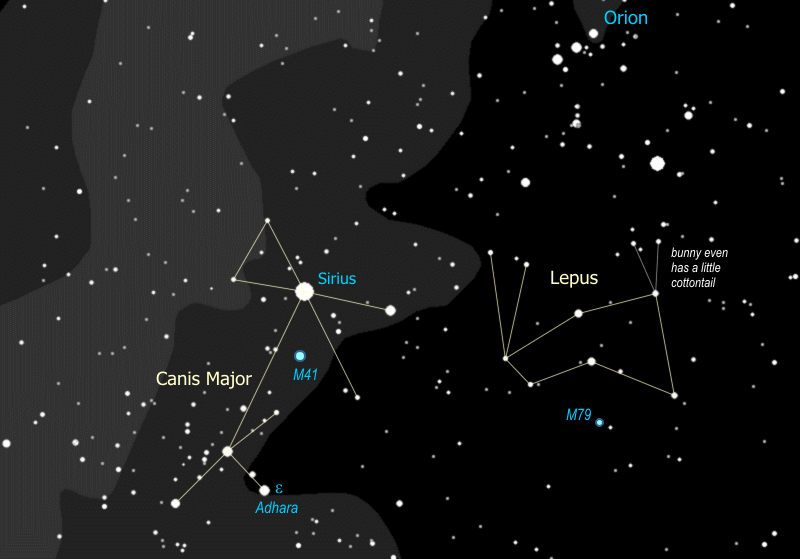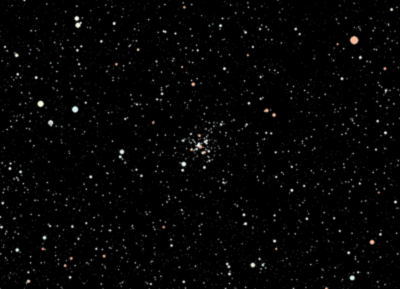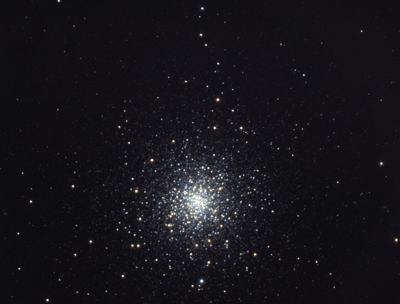Stargazing

|
Canis Major |

|
We saw the Little Dog Star, Procyon, in the Little Dog constellation, next
to Gemini, so where is the Big Dog?
- Remember the brightest star in the sky? It's Sirius, right there to the
south. It's called the Dog Star because it is actually the nose of the
Big Dog, Canis Major. {Trace out Canis Major, showing two eyes, the nose,
front legs, back legs & tail}. Some people see Sirius
as the dog's collar, I prefer seeing the eyes & nose myself.

- Of the stars you can see by eye, Sirius is the second closest, only about
9 light years away. Anyone know the closest? Yes, Alpha Centauri, which
is 4 light years away, and can only be seen in the Southern hemisphere.
Sirius is actually a double star. It has a white dwarf companion, a star
that has blown off its outer envelope of gases and collapsed into a burning
core that is about the mass of the sun packed into space about twice the
diameter of the earth. A white dwarf is what our sun will eventually
become. The companion can only be seen in the biggest telescopes, we
can't see it with our little bitty one.
- So part of the reason Sirius is so bright is because it is so close. It
is also about 20 times as bright as our sun, that obviously helps too.
The star at the dog's back foot is ε (epsilon) Canis Majoris,
also known as Adhara. This is the second brightest star in the Big Dog,
and is also four HUNDRED light years away. In reality it is 170 times
as bright as Sirius and almost 4,000 times as bright as our sun. If
Adhara were as close as Sirius you would be able to see it in the daytime
and it would cast a shadow at night... 16 times as bright as Venus (at
its brightest)!
- If you look with the binoculars right about where the dog's heart would be
you can see a gorgeous star cluster, M41. In fact if we have a clear, dark
sky you can see M41 with your eye alone, as a hazy spot. This is an
exceptionally bright cluster when you realize that it is nearly 2400 light
years away... six times as far as the Pleiades!

- Right next to Canis Major, the hunting dog, at the
feet of Orion, the great hunter, is Lepus the Hare. How's that for
being in the wrong place at the wrong time? This is one constellation
that really looks like what it is supposed to be. {Trace out Lepus,
showing the ears, nose, & little cottontail.}
- Check out the star at the bunny's chin -- even in binoculars you can see that
it's really a double star, the brighter one is pale yellow, similar to our
sun, and the fainter one above it is a small, orange star.
- There is one peculiar object of interest in Lepus, the globular cluster M79.
It is probably too difficult to see even in the telescope but if conditions
are especially clear and dark I will give it a shot.
What's so interesting about this globular cluster is that it's in the wrong part of the sky. All the clusters we've looked at are open clusters. Globular clusters are very different, and this globular cluster is all alone on this side of the sky. The summer sky is just filled with globular clusters -- for some reason all the globular clusters are close to the center of the Milky Way galaxy, and in the summer we are looking toward the center of the galaxy. Now we are looking out toward the edge of the galactic disk, and there's this one lone globular cluster -- why would that be?
Well, in November of 2003, it was discovered that the Milky Way is eating up a smaller galaxy -- it is called the Canis Major galaxy because most of what's left of it is in the direction of the Big Dog. It was caught in the gravity of the Milky Way and now is being pulled apart and is getting sucked into the disk of our galaxy. M79 is a globular cluster that was a part of that little galaxy, not originally part of our galaxy, which is why it's in the wrong place.
If you follow the line of the two stars at the center of the rabbit's body south to the next star, M79 is right next to that star. Instead of being a randomly scattered group of stars, a globular cluster is a well-defined ball, glittering with hundreds of thousands of stars. Globular clusters are rare - only about 150 are known, and they are completely different from open clusters like the Pleiades or M35 in Gemini.

The Pleiades are about 100 million years old, M79 is estimated to be at least 10 BILLION years old, making it so old that it formed before the disk of the Milky Way galaxy formed! While the Pleiades cluster has maybe 500 stars in total, M79 has several hundred thousand stars, maybe a million. The Pleiades are about 400 light years away and about seven light years across, while M79 is 40 thousand light years away and 100 light years across.
These numbers are typical -- globular clusters are much, much bigger than open clusters, and they are much much older - some are nearly as old as the universe!
So we've come full circle. We started with Orion the Hunter and here we are, back with Orion. Our winter sky tour is completed. For the die-hard stalwarts with a particularly high resistance to the night chill, we may continue on to observe some additional deep sky objects, perhaps some of the ones we skipped for the sake of time. Or we might learn a few additional constellations, like Leo which is on the rise about this time. But that's really part of the Spring Sky Tour, and we don't want to start getting ahead of ourselves, particularly since we've covered so much already.
 |
 |
| Back to The Zodiac | Go to Winter Index |
Questions
Your questions and comments regarding the Stargazing section are welcome.
You can e-mail the author, Randy Culp for inquiries,
suggestions, new ideas or just to chat.
Updated 18 July 2023
